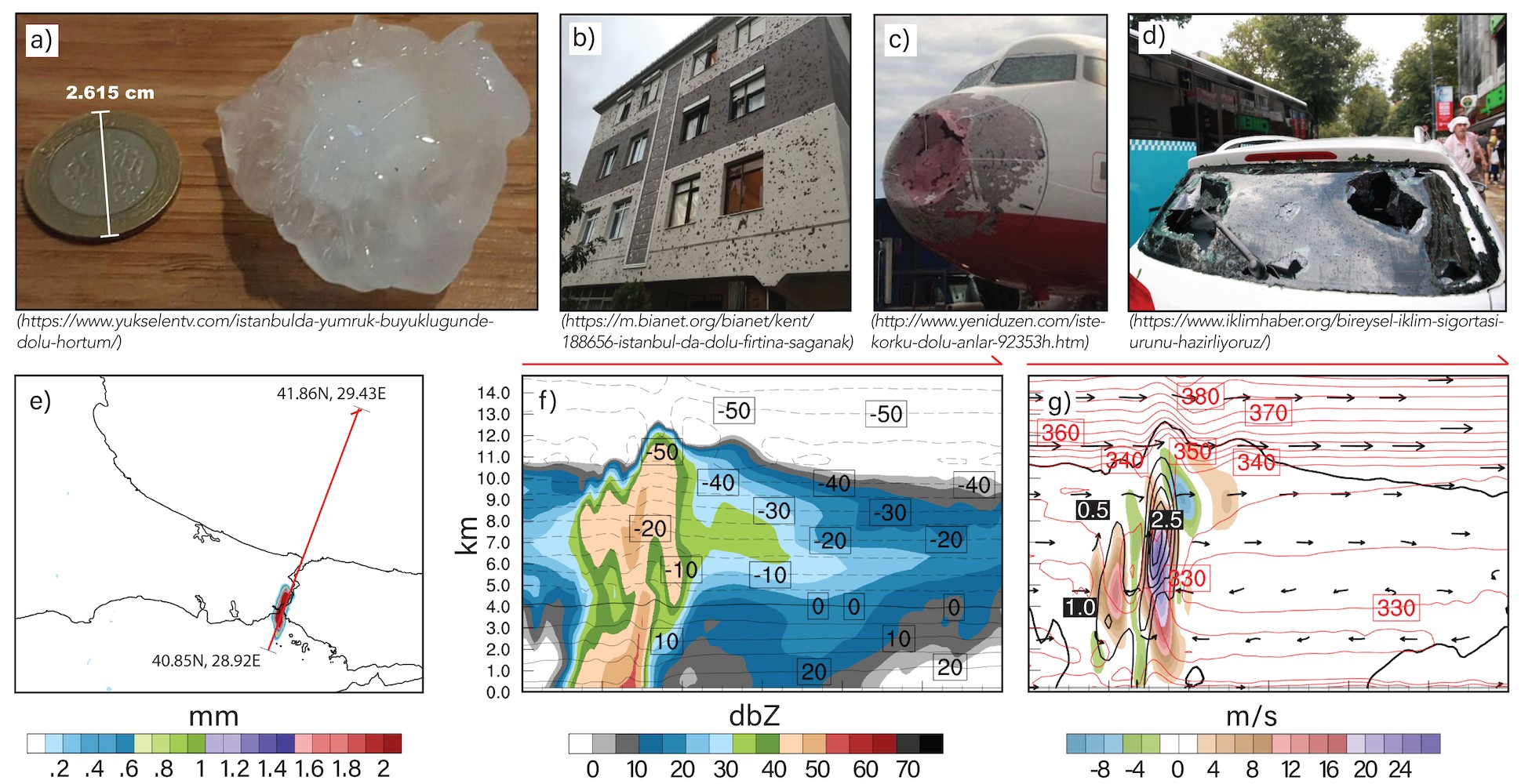Istanbul experienced a severe hail event on July 27, 2017. The hailstones reached large forms (between 3 and 6 cm in diameter), which caused significant damage to hundreds of buildings and thousands of vehicles, and injured tens of people. In this study, we investigated the capability of Weather Research and Forecasting (WRF) model in simulating this rather unique event. A sensitivity experiment involving different combinations of physics schemes was carried out. The simulation with YSU planetary boundary layer (PBL), Kain-Fritsch cumulus and Milbrandt microphysics schemes produced a more consistent hail simulation with the observations. The simulation yielded about 21.5 mm precipitation and 3.9 mm hail for the 15-minute duration about the time of the event by successfully reproducing typical characteristics of a hailstorm including anvil shape with the overshooting top and weak ecoregion, and strong up and downdrafts. Inside the simulated hailstorm cloud, the hail mixing ratio reached about 2.5 g/kg and updraft velocities up to 28 m/s.
 Figure 1. Various pictures from the hail event (a, b, c and d). Accumulated hail (mm) from 14:15 to 14:30 UTC (e) for the YKM simulation. Redline shows where the cross-section is taken. Cross-sections of reflectivity (shaded; dbZ) and temperature (dashed lines; °C) (f), hail mixing ratio (black contours; g/kg) with 0.5 g/kg intervals, vertical velocity (shaded; m/s), equivalent potential temperature (red solid lines; K) (black thick lines mark the reflectivity values at 5 dbZ), and wind direction (g) at 14:30 UTC on July 27, 2017 for the YKM simulation. x-axis indicates the number of grids along the red cross-section line.
Figure 1. Various pictures from the hail event (a, b, c and d). Accumulated hail (mm) from 14:15 to 14:30 UTC (e) for the YKM simulation. Redline shows where the cross-section is taken. Cross-sections of reflectivity (shaded; dbZ) and temperature (dashed lines; °C) (f), hail mixing ratio (black contours; g/kg) with 0.5 g/kg intervals, vertical velocity (shaded; m/s), equivalent potential temperature (red solid lines; K) (black thick lines mark the reflectivity values at 5 dbZ), and wind direction (g) at 14:30 UTC on July 27, 2017 for the YKM simulation. x-axis indicates the number of grids along the red cross-section line.
Highlights
- Sensitivity tests are conducted with Weather Research and Forecasting (WRF) model and performance of model physics are assessed for a heavy hailstorm over Istanbul
- Only simulations with Kain Fritsch cumulus scheme are capable of yielding sufficient hail over the city
- Simulations generally produce better temperature variations at inland stations than coastal stations
Publications related to this research:
Toker, E., Ezber, Y., Sen, O.L., (2020). Numerical simulation of a severe hailstorm over Istanbul. (Manuscript submitted to Atmospheric Research).
Abstracts and presentations related to this research:
Toker, E., Ezber, Y., Sen, O.L., (2020). Numerical simulation of a severe hailstorm over Istanbul. (Manuscript submitted to Atmospheric Research).
Toker, E., Sen, O.L., Ezber, Y., 2019. WRF Simulation Performance of the 27 July 2017 Hail Event Over Istanbul. 9th International Symposium on Atmospheric Sciences – ATMOS 2019, October 23-26, 2019 Istanbul, Turkey (ss. 456-463).
Toker, E., Sen, O.L., Ezber, Y., 2019. WRF Simulation Performance of the 27 July 2017 Hail Event Over Istanbul. 9th International Symposium on Atmospheric Sciences – ATMOS 2019, October 23-26, 2019 Istanbul, Turkey
Toker, E., Sen, O.L., Ezber, Y., 2018. Performance of WRF in Simulating the Hail Event over Istanbul on 27 July 2017. Scientific Congress of The Turkish National Union of Geodesy and Geophysics (TUJJBBK), May 30 - June 2, 2018 Izmir, Turkey.
Toker, E., Sen, O.L., Ezber, Y., 2018. Performance of WRF in Simulating the Hail Event over Istanbul on 27 July 2017. Quaternary Symposium of Turkey (TURQUA), May 2-5, 2018 Istanbul, Turkey.
Toker, E., Sen, O.L., Ezber, Y., 2018. Performance of WRF in Simulating the Hail Event over Istanbul on 27 July 2017. European Geosciences Union General Assembly (EGU), April 8-13, 2018 Vienna, Austria.